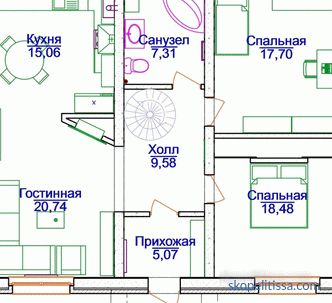The drainage system is an integral part of the roof construction, which collects rainwater and talan water from the roofs and then drains it into the storm sewers. External drains are known to all, because they are visible. But with all the internal drain did not all met, so in this article we will tell about it. Specifically, what it is, what materials it is assembled from, we will definitely tell about its structure and design features, as well as about the construction technology.
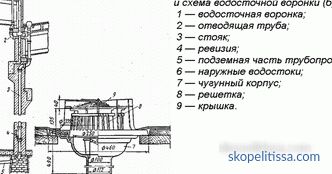
Construction of the internal drain
To begin with, this type of drainage system is used only on flat roofs. They consist of several elements interconnected by a bell-shaped method, that is, when the end of one element enters the end of another with tight clamping. And it provides one hundred percent sealing of the connection. However, masters often add sealant to ensure the tightness of the joint.
So, the first element, which is located on the roof plane, is a funnel. Its purpose is the primary collection of rain and melt water. The funnels on the market are represented by a huge variety. By design, they are flat and bell-shaped, according to the raw material from which they are made, plastic, stainless steel or copper alloys. It is the raw material most often that determines the price of the funnel.
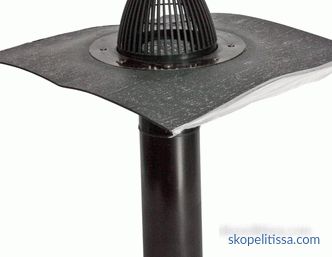
And the third division is by the size of the internal section. This is an important parameter that determines the efficiency of the entire drainage system. The diameter of the funnel is selected according to the diameter of the pipes used, which in turn are selected on the basis of the calculation. The latter is carried out taking into account the area of the roof from which water is collected.
We add that the funnels can be equipped with all sorts of additional functions. For example, heated, with protective filters, with water flow stabilizers. It is clear that such models are priced higher than standard ones. And in each case, the cost of the option, which is incorporated in the funnel, is taken into account.
The second element is the pipes for internal drainage, which are collected in the riser. In essence, it is a vertically positioned contour that connects the funnel with the outlet pipe contour. As mentioned above, the diameter of the pipe is chosen taking into account the area of the roofing plane. Usually, the riser is laid when building a house. And its location is inside the bearing wall, but not external. The fact is that inside such a wall pipes can freeze.
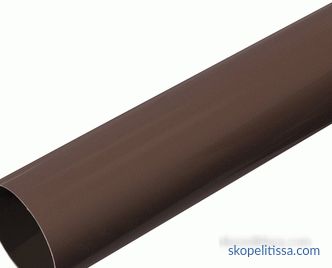
It is the location of the riser in the wall that determines its assembly technology. The fact is that any joint is a place of possible leaks. Therefore, the riser pipes are mainly connected by welding. In this case, the welding process is carried out by a master with high qualifications. Here quality comes first. At the same time try to collect the riser with the least number of joints.
The third element of the internal drainage system is a discharge pipe. Their purpose - to connect the riser with storm sewer. Usually two circuits are connected by a tap. At the same time, the discharge part of the drain should be located under a slight slope to the horizon in order to ensure the flow of the water. It should be noted that there are different types of internal drainage systems, where the discharge pipes can be located between the funnel and the riser. But more about that below.
So, the internal drain consists of three parts. But besides this, its package includes fasteners and inspection pipes (revisions). As for fasteners, it can be clamps or brackets with which all tubulars are attached to the supporting structures of the building.

As for the revision, it is a short length branch pipe, in the construction of which there is an opening closed by a lid. Note that revisions are a mandatory adaptation of the drain, through which the contours are cleaned (if necessary) and inspected for clogging or detection of defects.
Speaking about the structure of the internal drain, it should be noted that the roof plane is formed with the so-called leveling. That is, when the funnel is lower than the rest of the roof plane. It is in this way that water is collected on the site where the funnel is installed. That is, the liquid under the slope flows to it.
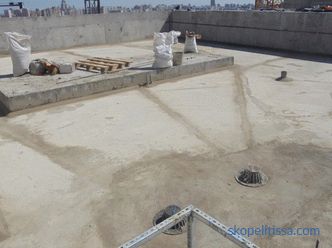
On our site you can familiarize yourself with the most popular projects of combined houses from manufacturers presented at the exhibition houses "Low-rise country." The availability of filters and a calculator online allows for a preliminary calculation of the total value of the house.
Variants of the internal drainage system
There are two types of internal drainage:
-
Self-flowing system . This is the simple design, inexpensive, but inefficient . Even the most accurate calculation cannot give an absolute guarantee that rainwater from heavy rain will be effectively removed from a flat roof. And this is her only minus . Of course, you can increase the diameters of the elements of the drain, but here you can not guess.
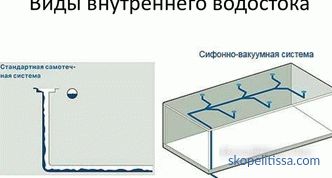
-
Siphon system . Firstly, this species differs from the gravity flow funnel used in it. Kolpakovidnye devices with flow stabilizers are installed here. It turns out that the whole drainage system from the funnel to the drain into the sewer is completely filled with water . That is, water column is formed. As soon as the water level inside the drain begins to fall, a vacuum zone is created in the funnel, a different vacuum, or a low pressure zone. And this is the reason that the funnel begins to suck water located on the surface of the flat roof with greater force. That is, the physical law of pressure difference works when the material tends from the high pressure zone to the low zone. At the same time, the speed of the movement of water in such a drainage system is much higher than in self-flowing . This means that this drain is well self-cleaning.
The video shows the internal drainage system based on the principle of vacuum-siphon action:
On our website you can to find contacts of construction companies that offer the service of auditing construction works, roof repair, reconstruction and rebuilding of houses. Directly to communicate with representatives, you can visit the exhibition of houses "Low-rise Country".
Rules and nuances of the installation process
It should be noted that the drain of the internal version will work for a long time and effectively if it is done correctly. It is possible to carry out the calculation correctly, to use the best and high-quality materials for its construction, but one even the smallest error during assembly or installation will lead to big problems. Therefore, it is worthwhile to be very demanding about compliance with fairly simple rules.
-
If the flat roof of a small house is , then you can install two water-receiving funnels on it. If the area is large , then it is necessary to calculate the required number of water receiving elements and evenly distribute them over the entire plane of the roof. In the code of practice, it is stated that one funnel should be installed on an area of 20 m² .
-
It is impossible to mount funnels closer than 1 m from the walls of the building.
-
The distance between adjacent funnels connected to one pipe riser should not be less than 20 m.
-
If one of metals was chosen as the material for the elements of the drainage system, then all the drain should be equipped with a heating cable . This is a necessary measure that will save the entire system from deformation and rapid failure.
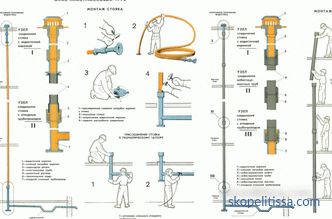
This could be interesting! In the article on the following link read about the requirements for external drainage from the roof and the technology of its construction.
-
If the flat roof of the house is multi-level , then at each level its own drainage system is installed with an accurate calculation of the elements both in quantity and in parameters. Special attention to those multi-level roofs , where the difference of the planes is more than 4 m. >. Special attention is paid to this parameter, because repairing the internal drain system is much more difficult than external .
-
Usually the entire surface of the plane is divided into sections. At the same time, 150-200 m² is allocated for each riser.
-
The roof slope in the direction of the intake funnel should be 1-2 °.
-
The cross section of pipes is calculated taking into account such a ratio: a riser with a section of 1-1.5 cm ² should be installed per 1 m² of roof plane. This is the simplest form of calculation, but it is usually effective.
-
All risers must be installed in heated areas of the building , otherwise it is likely that in winter they will simply freeze .
-
The funnel is installed so as to fully ensure its tight fit to the plane of the roof structure. Therefore, roll material is usually laid on top of the sides of the funnel.
-
To reduce the noise of moving water, pipe elements are recommended to close noise-attenuating materials .
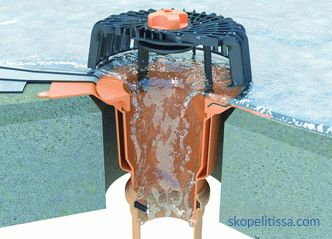
As practice shows, it is the installation of the funnels that causes some difficulties. Here the main thing is to achieve complete tightness of the clamp. Therefore, in the hole that is made on the flat roof to install the water intake, insert the glass. It is he who will form the intake and provide sealing.
The glass itself is installed only when a lining carpet is laid on the roof. That is, waterproofing material, which is always placed under the roofing, even roll. The sides of the glass should lie on top of waterproofing, which will already ensure the tightness of the structure. The fastening of the funnel is carried out with the help of adhesive compositions or screws.
Then the roofing material is laid on the roof. As for the formation of the hole, it is usually done this way:
-
lay a strip of roofing material over glass ;
-
then cut with a sharp knife a hole exactly the edges of the device ;
-
then set the cap or protective lattice .
The video shows how to properly install a water intake funnel on a flat roof:
may be interesting! In the article on the following link read about suburban real estate as an investment: is there a benefit and does it make sense to invest savings.
We add that the funnels, consisting of two parts, justify themselves one hundred percent. They easily compensate for the movement of insulation with changes in air temperature.
There is one more thing that concerns the effective operation of the internal drain. This connection funnels to one riser. Usually for this purpose, diverting pipe sections are used, which are laid under the ceiling of the building, but above the ceiling. Since the drain is a gravity flow system, these areas should be laid with a slight slope - 1-2 °. That they must be sure to isolate noise absorbing materials.
And the last. Equally important is attached to the heating system of the internal drain. The most important thing is to prevent the pieces of ice inside the system from blocking the cross section, which will lead to blockage. Therefore, it is near the water funnels that the heating cable is laid. There are many different locations, one of them in the photo below.
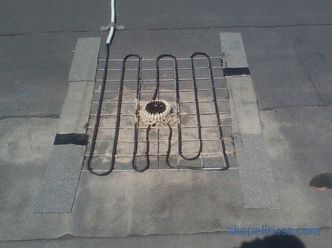
It might be interesting! In the article on the following link read about the house-transformer - allows tenants to change the location and size of the premises.
Conclusion on the topic
The construction of the drainage system of internal execution requires a special approach to the implementation of installation processes, where the most important is the tightness of the entire structure as a whole. If even the smallest gap is found, it is the cause of the big troubles associated with wet walls, leaks from the roofing plane, which will necessarily lead to damage to the finish. And yet - to maintain the drain of this type is much more difficult.


